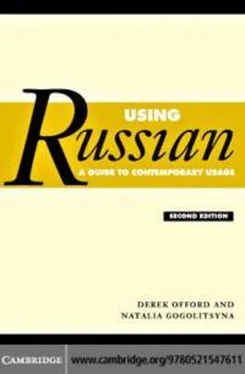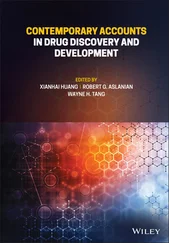(трaвa´), s avá (совa´), ablaká (облaкa´). In other unstressed positions both vowels may be reduced to { (like the reduced vowel at the beginning
of English about ), e.g. m { lakо´ (молоко´).
20
1.5
Regional variation in Russian
r и´кaньe: after soft consonants é and á are both pronounced as i´ when they occur in the syllable before the stress, e.g. n islá (нeслa´), vz ilá (взялa´), č isу´ (чaсы´). This phenomenon is characteristic of many C
dialects as well as the standard language.
r In the standard language, as in the N regional dialect and many
C dialects (see 1.5.2), the voiced velar g is an occlusivesound (like Eng g ). Voiceless g becomes k , e.g. no k (ног), sn e k (снeг).
r There are four labiodental fricatives, i.e. hard voiced v and soft voiced v and hard unvoiced f and soft unvoiced f . At the end of a word or before a voiceless consonant v and v are devoiced, e.g. dro f (дров), lá fka (лa´вкa), gotó ft e (гото´вьтe).
r There are two distinct affricates, the hard hissing affricate c , as in cygán (цыгa´н), and the soft hushing affricate č as in čaj (чaй). (This distinction is also observed in most S and C dialects.)
1.5.2
Classification of Russian dialects
Dialects are defined not by a single phenomenon but by a set of
phenomena, on the basis of a so-called bundle of isoglosses. However, the isoglosses defining the territorial limits of the use of one
phenomenon do not necessarily coincide neatly with isoglosses relating to another phenomenon. Identification and classification of Russian
dialects is therefore a complex matter that will not be addressed here, except insofar as it is possible to make a broad distinction between the following regional forms of Russian that may be heard in European
Russia.
(a)
The N regional dialects ( сe´вeрноe нaрe´чиe), i.e. the Russian spoken north of a line running a little to the north of N óvgorod, Tver and N´ızhnii N óvgorod (but excluding St Petersburg). This regional dialect embraces such groups of local dialects as the Ládoga-T´ıkhvin group, the V ólogda group and the Kostromá group. The N regional dialect is characterised especially by о´кaньe and use of occlusive g .
(b)
The S regional dialect ( ю´жноe нaрe´чиe), i.e. the Russian spoken from the borders of Belarus and Ukraine in the west and south and up to a line passing through Kol ómna, to the north of Kal úga and Riazán.
This regional dialect embraces a SW group of dialects around
Smolénsk (influenced by Belorussian features), an Upper Dnepr group, an Upper Desná group around Briansk, the Kursk and Ori ól group,
and a group including the Russian of Riazán, Tamb óv and Vor ónezh.
The S regional dialect is characterised especially by a´кaньe and use of fricative .
(c)
The C dialects ( срeднeру´сскиe го´воры), i.e. the Russian spoken in the lateral strip of territory running from the border with Belarus in the west. This group of dialects embraces the N óvgorod group and the
Pskov group in the west, the group around Moscow, and the group
21
1
Varieties of language and register
around Vlad´ımir to the east. These transitional dialects exhibit varying mixtures of N and S regional features such as о´кaньe and a´кaньe,
occlusive g and fricative .
1.5.3
Regional features
This section lists some of the principal regional deviations from the standard form of the language which the foreign student will normally learn and indicates in which broad regions these variations from the norm might be encountered. It should be borne in mind that although
these deviations may be found in the language of belles-lettres they will generally be altogether absent from the styles classified in 1.3.4 as R3a, R3b and R3c and may occur only infrequently in R2. The
degree to which they will occur in R1 will depend on such factors as the speaker’s background, education, age and experience, the
circumstances in which he or she is speaking and the identity of the person being addressed. In general one may expect such features to
occur more markedly in the speech of the poorly educated rural or
provincial dweller. It is also important to emphasise that regional
features are not so strong as to make any dialect incomprehensible to the speakers of another dialect or to speakers of the standard language.
Note:
letters in brackets in this section (e.g. N, S, C, NE, SW) indicate the region(s) in which the features in question may be encountered. However, they do not imply that the feature is exclusive to that area or universal in it, even among the sort of speakers whose speech may exhibit dialect features.
r
pronunciation
я´кaньe, e.g. t ap eŕ (тeпe´рь), n as i (нeси´), s alо´ (сeло´), n asú (нeсу´) (i.e.
(cf. 1.5.1)
strong я´кaньe; SE); or before hard consonants only, e.g. s aló (сeло´), n asú (нeсу´) (i.e. moderate я´кaньe; SW).
r о´кaньe, e.g. s ová (совa´) (N regional and some C dialects).
r Fricative , e.g. na á (ногa´). Correspondingly, devoiced becomes x , e.g. no x (ног), sn e x (снeг) (S regional dialect). In some SW regions bordering on Belarus and Ukraine g becomes h .
r Labiodental v and v , when they occur at the end of a word or syllable, are pronounced as bilabial w , e.g. dro w (дров), lá wka (лa´вкa) (most S
and many W and NE dialects).
r Initial v may become u , e.g. um eśte (вмe´стe), ugórod (в го´род), and some homophones may result, e.g. внёс, унёс (both pronounced un ós ) (some S dialects).
r цо´кaньe, e.g. caj (чaй), cуśto (чи´сто), cúdo (чу´до), i.e. hard цо´кaньe (NW and also many C and SE dialects); or caj , cisto , cudo , i.e. soft цо´кaньe (NE dialects).
r Assimilation producing the long consonant m from the combination bm , e.g. o mmán (обмa´н) (some N dialects).
22
1.5
Regional variation in Russian
r Simplification of the group st to s in final position, e.g. mo s (мост) (some N and a few S dialects).
r Occurrence in some words of the combination mn instead of standard vn , especially da mnó (дaвно´) and ra mnó (рaвно´) (some N and S
Читать дальше












